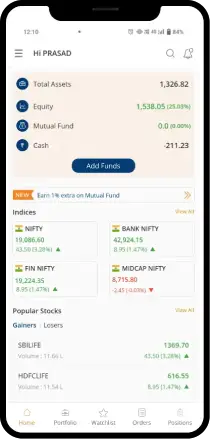
Table of content
What is Net Asset Value (NAV) in Mutual Funds?
NAV is the acronym for Net Asset Value, and it represents the net value of an entity. In the case of mutual funds, NAV means the market value per unit of the fund. NAV of a mutual fund scheme is derived basis the difference between total assets and total liabilities divided by the total number of outstanding units.
A mutual fund NAV represents the per share or unit price of a mutual fund scheme on a specific date or time. Usually, the NAV of a new mutual fund (NFO) scheme begins at Rs. 10 and gradually increases as the assets under management grows. All mutual fund schemes including open-ended, closed-ended, and interval schemes across equity, debt and hybrid categories have NAVs which are driven by market movements.
How does NAV work?
Net Asset Value (NAV) is a crucial metric in mutual funds, representing the per-unit value of the fund. It is calculated by subtracting the total liabilities of the fund from its total assets and then dividing this result by the number of outstanding units. Essentially, NAV reflects the market value of all the securities held in the fund's portfolio, including stocks, bonds, and other assets, minus any liabilities. NAV is computed at the end of each trading day, providing investors with an up-to-date valuation of their holdings. Understanding NAV is essential for assessing the performance and value of mutual fund investments over time.
NAV for Mutual Funds
Mutual Funds are not traded in real-time. Considering the various assets and liabilities, the NAV of Mutual Funds is calculated based on the trading method. Let us check out what these assets and liabilities are.
-
Assets under Mutual Funds
Assets under Mutual Funds include the total market value of the fund’s
- Investments
- Receivables
- Cash and cash equivalents
- Accrued income
Based on the closing price of the various securities, the market value of these assets is calculated at the end of the day. The total sum of all these assets and their variants together constitutes assets.
-
Liabilities under Mutual Funds
Liabilities under Mutual Funds include:
- Money owed to the lenders
- Outstanding payments
- Fees and charges owed to associated entities
- Foreign liabilities, if any
- Accrued expenses
The foreign liabilities include shares of NRIs, sale proceeds pending repatriation, and income or dividends for which payments are pending to non-residents. Staff salaries, operating expenses, management expenses, distribution, etc., falls under the accrued expenses category.
NAV Formula
The formula used for the calculation of Net Asset Value is:
Net Asset Value = (Total Assets - Total Liabilities) / Total Number of Outstanding Shares
The assets of a mutual fund scheme include its investments, which can be equity shares, preference shares etc. in case of equity mutual funds or debentures, bonds, government securities in case of debt mutual funds and cash holdings. The liabilities include fund manager fees, accrued expenses and payments.
Importance of NAV for Investors
Investors consider the NAV and price of an equity share the same. But there are differences in calculation. In the case of calculation of the price of equity shares, only the liquid assets of the company are included. Whereas when NAV is calculated, both liquid and non-liquid assets are considered. While the total equity represents a company’s working capital, NAV depicts a company’s total monetary worth.
Calculation of NAV
NAV can be calculated in two ways. They are:
-
Daily Valuation
Every day, once the stock market closes at 3:30 pm, all the mutual fund investment companies evaluate the total worth of their investment portfolio. On the next day, the market reopens with the previous day’s closing price. Using the formula mentioned above, the fund houses calculate NAV after deducting all the expenses.
-
General Calculation
The general NAV is the price of the equity share and the total cost of the individual shares. The general calculation gives the market value of an asset and is subject to market movement.
Example of NAV
To illustrate how NAV works, let's consider an example. Suppose a fund holds ₹ 200 crore in various securities, based on the day's closing prices for each security. Additionally, the fund has ₹ 10 crore in cash and cash equivalents, ₹ 5 crore in total receivables, and ₹ 1 lakh in accrued income for the day.
As for liabilities, the fund owes ₹ 15 crore in short-term liabilities and ₹ 3 crore in long-term liabilities. The accrued expenses for the day amount to ₹20,000. Moreover the fund has 1 crore shares outstanding.
-
To determine the per-share NAV, first calculate the fund's NAV:
Total assets:
₹200,00,00,000 + ₹10,00,00,000 + ₹5,00,00,000 + ₹1,00,000 = ₹215,010,000Total liabilities:
₹15,00,00,000 + ₹3,00,00,000 + ₹20,000 = ₹18,020,000NAV calculation:
₹215,010,000 − ₹18,020,000 = ₹196,990,000 -
Next, calculate the per-share NAV:
Per-share NAV = (Total Assets - Total Liabilities) / Total Number of Outstanding Shares
₹196,990,000/10,000,000 = ₹19.70
So, in this example, the per-share NAV of the mutual fund is ₹19.70.
How Net Asset Value Affects the Performance of a Fund?
Investors generally believe that lower NAV means the scheme is cheaper and better. But this is not the correct way to judge mutual fund schemes. A fund with a lower NAV may not always be the best investment.
For example, consider two funds, Fund A and Fund B with NAV of Rs. 10 and Rs. 100 respectively. After a year, the NAV of both funds grows by 10%. So, the NAV for Fund A becomes Rs. 11 while the NAV of Fund B grows to Rs. 110. As you can see, a 10% growth in NAVs of both the funds reflects in the same manner, irrespective of the base NAV. So, the NAV doesn’t really matter. What matters is the performance of the fund, which depends upon its underlying stocks and investments.
So, while a rising and falling NAV can help you judge the short-term performance of a fund, you should instead focus on long-term performance parameters like stock selection, Sharpe ratio, Standard Deviation, etc.
NAV Vs Stock Price
The NAV pricing structure for the trading of shares of mutual funds varies predominantly from that of common stocks or equities that are issued by companies and listed on a stock exchange.
Through an Initial Public Offering (IPO) and possibly subsequent additional offerings, a company issues a limited number of equity shares that are sold on markets like the Bombay Stock Exchange (BSE). The supply and demand for shares in the market determines the price of stocks. The only factor influencing the value or pricing of equities is market demand.
On the other hand, the value of a mutual fund is decided by the total amount invested in the fund, its outstanding shares, and its operating expenses. Nevertheless, the fund's performance is not shown by the NAV. The NAV of a mutual fund is relatively unimportant for evaluating the performance of the fund because fund shareholders get almost all of its income and realised capital gains. Rather, the best metric to evaluate a mutual fund is its total return, which takes into account both the dividend payments and the performance of the underlying securities.
NAV allotment varies based on type of mutual fund investment
The method of NAV allotment can vary depending on the type of mutual fund investment. For instance:
Open-Ended Funds:
In open-ended mutual funds, NAV is calculated daily. Investors can buy or sell units at the prevailing NAV, which is updated at the end of each trading day.Close-Ended Funds:
Close-ended funds have a fixed number of units and are typically listed on stock exchanges. The NAV is also calculated daily, but the trading price may differ from the NAV due to market demand and supply.Interval Funds:
These funds allow buying and selling at specific intervals. The NAV for interval funds is calculated at the end of each interval period, and transactions occur based on this NAV.Exchange-Traded Funds (ETFs):
ETFs trade on stock exchanges like individual stocks. Although the NAV is calculated daily, the trading price fluctuates throughout the day based on market conditions.
Understanding the NAV allotment based on the type of mutual fund helps investors make informed decisions according to their risk tolerance and investment goals. Each type of fund has a different risk and return profile, which is reflected in its NAV behaviour.
Furthermore, NAV allotment can also vary depending on the mode of payment for purchasing mutual fund units.
-
Lump Sum Investments:
When making a lump sum investment, the method of payment affects the NAV allotment:- Cheque Payments: You will not receive the same-day NAV as cheque payments are realised later.
- Electronic Payments: Using RTGS, NEFT, UPI, or instant credit banks ensures that the payment reaches the AMC immediately. If you wish to buy more units during a market dip, ensure your electronic transfer reaches the AMC's account before the cut-off time.
-
SIPs (Systematic Investment Plans):
For SIPs, the NAV is allotted when the payment is realised in the AMC's collection account, regardless of the payment mode. This depends on banking settlement systems and automated SIP mandates. -
Other Transactions:
- NFOs (New Fund Offers): The NAV of the allotment date is final.
- Switches: The NAV allotment depends on the pay-out cycle of the switch-out fund.
While NAV precision is not crucial for long-term investments, minor changes in NAV can significantly impact short-term investments.
NAV mistakes to avoid
When investing in mutual funds, avoiding common NAV-related mistakes can help maximise returns and minimise risks:
Thinking a Low NAV is Good:
Buying more units at a lower NAV does not guarantee higher returns. Two funds with the same portfolio will yield similar returns regardless of their NAV.Thinking a High NAV means the Fund is Good:
A high NAV does not necessarily indicate a better-performing fund. Instead, look at the historical NAV trends to assess past performance potential.Taking an Increase in the NAV as a Sign to Sell:
Do not sell units solely because the NAV has increased. Evaluate the overall performance of the fund before deciding to redeem units.Ignoring the Expense Ratio:
The expense ratio, which includes management fees and other costs, is deducted from the fund's assets, impacting the NAV. High expense ratios can erode returns, so consider funds with lower expense ratios for better long-term performance.Timing the Market:
Attempting to buy or sell mutual fund units based on daily NAV fluctuations can lead to poor investment decisions. Focus on long-term investment goals rather than short-term market movements.Not Considering Distributions:
NAV can drop when the fund pays out dividends or capital gains distributions. Investors should understand that such distributions are not losses but returns on their investment.Overlooking Fund Performance:
A low NAV does not necessarily indicate a poor-performing fund. Evaluate the fund's historical performance, risk profile, and management quality rather than relying solely on the NAV.Ignoring Load Fees:
Some mutual funds charge entry (front-end load) or exit (back-end load) fees. These fees can reduce the effective NAV at which you buy or sell units, impacting your overall returns. Consider funds with no or low load fees.
By understanding and carefully considering these aspects of NAV, investors can make more informed decisions and avoid common pitfalls in mutual fund investments.





